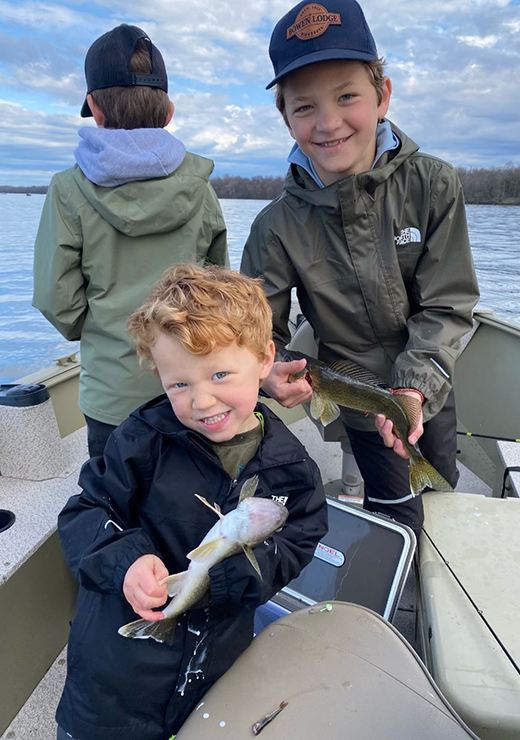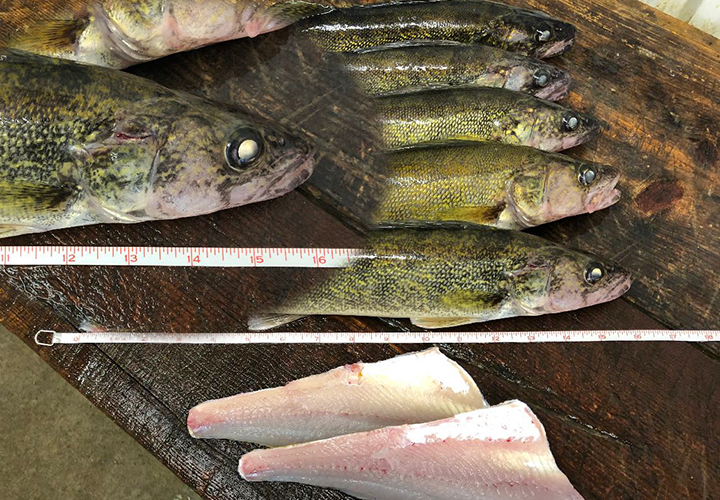Cooperative Walleyes from Lake Winnie’s strong 2018 year class.
After our first full week of fishing for the 2022 season, we can honestly say that it’s been a wild ride. Despite the later than average ice-out, we managed to have all the docks in, and the chores finished in time for our fishing opener guests. And luckily, we did, because for our guests, the fishing opener was fantastic.
Typical of most openers, folks did not need to travel far to get in on good walleye action. In fact, several of our friends caught walleye limits within view of our marina on Saturday. Also typical of most seasons, from Sunday on, the epicenter of walleye fishing action has been on Lake Winnie.
“Post Spawn” accurately describes the timing for the walleye opener. Female fish, mostly spawned out, were already transitioning out of Cutfoot Sioux. Male fish, many of them still in “spawning mode” lingered in traditional breeding areas, hoping to catch the last wave action. By week’s end, 90% of the male fish we’re catching show no signs of milt, so they’re now focused on feeding rather than breeding.
So far, there hasn’t been any day that the fish weren’t biting, but honestly, there have been days when folks have had to battle tough fishing conditions to earn their catches. Strong Winds, mainly from the west, southwest, have whitened the surface water on the big lake and because of that, most folks are fishing within spotting scope view from the lodge. We’ve watched folks bobbing in the waves, but upon their returns, we’ve also watched them cleaning lots of fish.
Tamarack Point, The Three Sisters, Plughat Point, The River Channel and Bowen’s Flats have been good most days. The Rock Pile, The Dugouts, Farley Creek, and Pigeon River have been good on the days that those spots were within safe travel distances.
Surface water temperatures remain cool, ranging between 51 to 53 degrees on the big lake, somewhat cooler than that in Big Cutfoot, where we still find an occasional high 40 degree reading. The most common range is currently 50 to 52 degrees.
Jig and minnow combinations dominate the presentation, 1/8 to ¼ ounce weights have been most popular, when walleyes are located shallow, over weed stubble, 1/16-ounce jigs are used to keep the live bait running clear. Jig color preference is subjective and often more important to the angler than it is to the fish. Firetiger, watermelon, blue-glow, pink-glow, chartreuse yellow and Chartreuse Green have all been productive this week. Try your favorite color and it will probably work, but don’t be afraid to experiment, there are days when fish do show preferences.
Larger size minnows are working better than small ones, so pay attention to your offerings. Shiners have been available, but in very limited quantities and timing their availability has been sporadic, they sell as fast as they come in. Fatheads, rainbows and small “pike suckers” have been easier to come by, but even those supplies are sporadic. “Size of the bait is more important than minnow species,” one of our veteran fishing guides tells us. “A 3-to-4-inch chub will often out-perform shiners of the same size and are not only a lot more durable, but more available and affordable too. The same is true for other minnows, if it’s 3 to 4 inches long, healthy and has a little shine to attract attention, it will work.” He added.
Good fish management requires a certain level of flexibility on the part of anglers. So, we suggest paying close attention to the sizes of fish you catch. Walleye sizes have reflected the dominant year class populations in the lake. Folks are catching a lot of fish from the 2019-year class which are still small, we think, for harvest today, but will be attractive to anglers later this year. Late August and on through the fall should be good for timing for those 2019 fish, when almost all of them will exceed 14 inches and many will exceed 15 inches.
Fish from the strong 2018-year class are also being caught in good numbers, today, those fish range in size from 15 to 16 inches. While they don’t necessarily dominate the catch, they are available in numbers strong enough to suggest targeting them. We believe that this summer, willing anglers could participate in voluntary size boundaries for harvest. A minimum size of 15 inches, up to the legal maximum of 17.9 inches, would be a realistic goal for folks to set.
Nice walleye from Lake Winnie’s 2013 year class
Walleyes from the also strong 2013-year class are caught daily too and in good numbers. For a time, we were on board with encouraging anglers to harvest their legal possession limit of 1 walleye over 23 inches. Today, we’re taking a more conservative stance about that. While keeping that 1 fish over 23 inches is ultimately an angler’s choice, we are advising release rather than harvest. In our view, having more spawning size female fish in the system will become important in the future. Since good “eater size” fish are much available now than they were a few years back, we think it’s a reasonable suggestion.
Because walleye fishing always dominates the first week of every season, new about other species is limited.
Perch are either spawning now, or recovering from spawning and show up only sporadically at the fish cleaning tables.
Large Northern Pike have spawned already and moved away from shallow water. Anglers are picking up small ones while the fish for walleyes, if anyone is targeting them, we have not heard the news. I you like pike to eat, you’ll catch enough of the “eaters” while you’re jigging for walleyes.
Panfish haven’t shown up in shallow water locations yet and like the pike, if anyone is targeting them, we have not heard the news yet. Next week’s report could carry news along those lines, but it depends on what happens with the weather.
If you’re headed for the lake and don’t want to fight crowds at public landings, you can always launch your boat here at Bowen Lodge. It’s not free, but we think you night like what you get in return for your money.





















